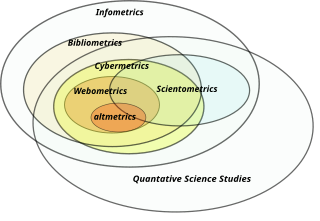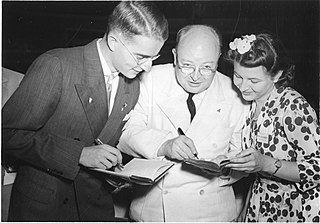Information retrieval (IR) in computing and information science is the task of identifying and retrieving information system resources that are relevant to an information need. The information need can be specified in the form of a search query. In the case of document retrieval, queries can be based on full-text or other content-based indexing. Information retrieval is the science of searching for information in a document, searching for documents themselves, and also searching for the metadata that describes data, and for databases of texts, images or sounds.

Information science is an academic field which is primarily concerned with analysis, collection, classification, manipulation, storage, retrieval, movement, dissemination, and protection of information. Practitioners within and outside the field study the application and the usage of knowledge in organizations in addition to the interaction between people, organizations, and any existing information systems with the aim of creating, replacing, improving, or understanding the information systems.

Informetrics is the study of quantitative aspects of information, it is an extension and evolution of traditional bibliometrics and scientometrics. Informetrics uses bibliometrics and scientometrics methods to study mainly the problems of literature information management and evaluation of science and technology. Informetrics is an independent discipline that uses quantitative methods from mathematics and statistics to study the process, phenomena, and law of informetrics. Informetrics has gained more attention as it is a common scientific method for academic evaluation, research hotspots in discipline, and trend analysis.
The National Information Standards Organization is a United States non-profit standards organization that develops, maintains and publishes technical standards related to publishing, bibliographic and library applications. It was founded in 1939 as the Z39 Committee, chaired from 1963-1977 by Jerrold Orne, incorporated as a not-for-profit education association in 1983, and assumed its current name in 1984.
Howard D. White is a scientist in library and information science with a focus on informetrics and scientometrics.
The Journal of the Association for Information Science and Technology is a monthly peer-reviewed academic journal covering all aspects of information science published by Wiley-Blackwell on behalf of the Association for Information Science and Technology. The journal publishes original research and rapid communications, as well as book reviews and announcements of the association. Occasional special issues appear with contents focused on a single topic area.
Michael Keeble Buckland is an emeritus professor at the UC Berkeley School of Information and co-director of the Electronic Cultural Atlas Initiative.
Bibliographic coupling, like co-citation, is a similarity measure that uses citation analysis to establish a similarity relationship between documents. Bibliographic coupling occurs when two works reference a common third work in their bibliographies. It is an indication that a probability exists that the two works treat a related subject matter.

Jesse Hauk Shera was an American librarian and information scientist who pioneered the use of information technology in libraries and played a role in the expansion of its use in other areas throughout the 1950s, 60s, and 70s.
Christine L. Borgman is Distinguished Professor and Presidential Chair in Information Studies at UCLA. She is the author of more than 200 publications in the fields of information studies, computer science, and communication. Two of her sole-authored monographs, Scholarship in the Digital Age: Information, Infrastructure, and the Internet and From Gutenberg to the Global Information Infrastructure: Access to Information in a Networked World, have won the Best Information Science Book of the Year award from the American Society for Information Science and Technology. She is a lead investigator for the Center for Embedded Networked Sensing (CENS), a National Science Foundation Science and Technology Center, where she conducts data practices research. She chaired the Task Force on Cyberlearning for the NSF, whose report, Fostering Learning in the Networked World, was released in July 2008. Prof. Borgman is a Fellow of the American Association for the Advancement of Science (AAAS), a Legacy Laureate of the University of Pittsburgh, and is the 2011 recipient of the Paul Evan Peters Award from the Coalition for Networked Information, Association for Research Libraries, and EDUCAUSE. The award recognizes notable, lasting achievements in the creation and innovative use of information resources and services that advance scholarship and intellectual productivity through communication networks. She is also the 2011 recipient of the Research in Information Science Award from the American Association of Information Science and Technology. In 2013, she became a fellow of the Association for Computing Machinery.
The following outline is provided as an overview of and topical guide to information science:
The Information School or iSchool of the University of Sheffield, in Sheffield, South Yorkshire, England, was founded in 1963 as the University's Postgraduate School of Librarianship and became in 2010 the first UK iSchool. Other names were the Postgraduate School of Librarianship and Information Science and Department of Information Studies (1981-2011). As of 2021, it employs 33 academic staff, 16 administrative/support staff, 6 affiliated research staff, and has about 65 research students. The current head of school is Professor Val Gillet.

Mortimer Taube was an American librarian. He is on the list of the 100 most important leaders in American Library and Information Science of the 20th century. He was important to the Library Science field because he invented Coordinate Indexing, which uses "uniterms" in the context of cataloging. It is the forerunner to computer based searches. In the early 1950s he started his own company, Documentation, Inc. with Gerald J. Sophar. Previously he worked at such institutions as the Library of Congress, the Department of Defense, and the Atomic Energy Commission. American Libraries calls him "an innovator and inventor, as well as scholar and savvy businessman." Current Biography called him the "Dewey of mid-twentieth Librarianship." Mortimer Taube was a very active man with varying interests such as tennis, philosophy, sailing, music, and collecting paintings.

Frederick Wilfrid ("Wilf") Lancaster was a British-American information scientist. He immigrated to the US in 1959 and worked as information specialist for the National Library of Medicine in Bethesda, Maryland from 1965 to 1968. He was a professor at the University of Illinois, Urbana from 1972 to 1992 and professor emeritus from 1992 to 2013. He continued as an honored scholar after retirement speaking on the evolution of librarianship in the 20th and 21st century. Lancaster made notable achievements with early online retrieval systems, including evaluation studies of MEDLARS. He published broadly in Library and Information Science over a period of four decades and continuously emerged as a visionary leader in the field, where research, writing, and teaching earned him the highest honors in the profession. Lancaster excelled at many fronts: as scholar, educator, mentor, and writer.

Watson Davis (1896–1967) was the founder of the American Documentation Institute (ADI), the forerunner of the Association for Information Science and Technology, and a pioneer in the field of Library and Information Science.

The Science and Technology Information Center (STIC) is an Ethiopian organisation which provides information to support scientific and technological (S&T) activities in the country. STIC has published information on the financing of research and development and on the nature and progress of innovative projects, and in 2014 was planning to introduce bibliometric monitoring of publications in S&T. The center has also provided information and communications technology facilities including a digital library, a patent information system, an automated personnel management system, and a S&T-related database.

Claire Kelly Schultz was an American computer consultant and academic. She was a leading figure in the early development of automated information retrieval systems and information science. A "documentalist", she was particularly known for her work in thesaurus construction and machine-aided indexing, innovating techniques for punch card information retrieval.
Allen Kent was an American information scientist.
Pauline Atherton Cochrane is an American librarian and one of the most highly cited authors in the field of library and information sciences. She is considered a leading researcher in the campaign to redesign catalogues and indexes to provide improved online subject access in library and information services as well as "a leading teacher and theorist in cataloging, indexing, and information access."

Ronald Rousseau is a Belgian mathematician and information scientist. He has obtained an international reputation for his research on indicators and citation analysis in the fields of bibliometrics and scientometrics.









